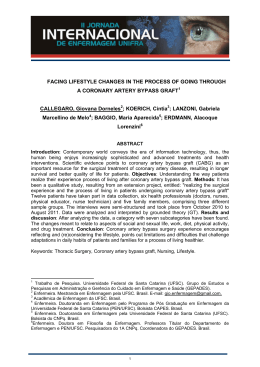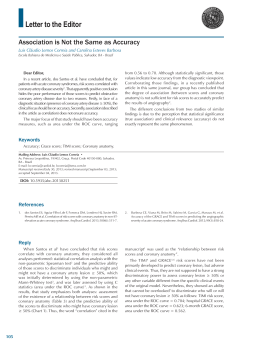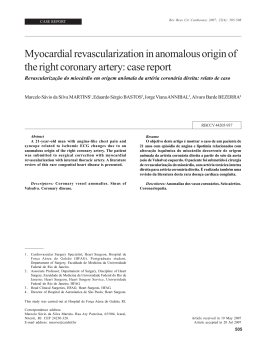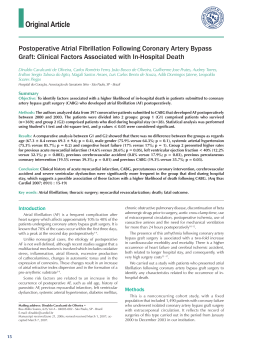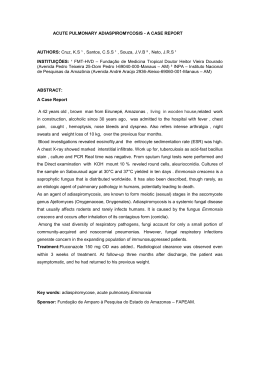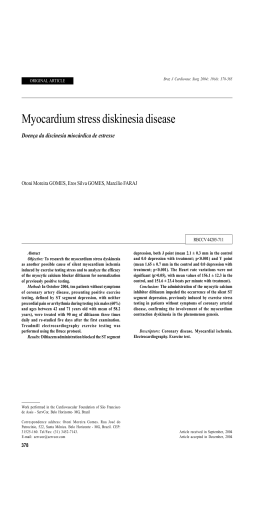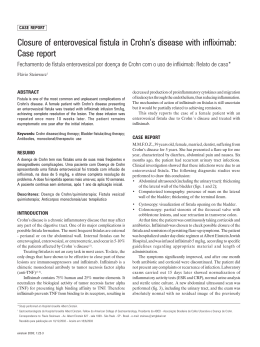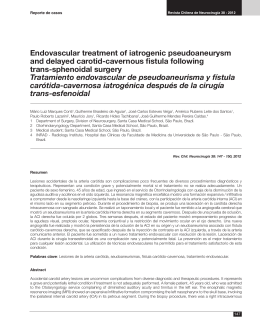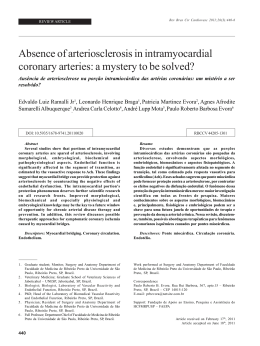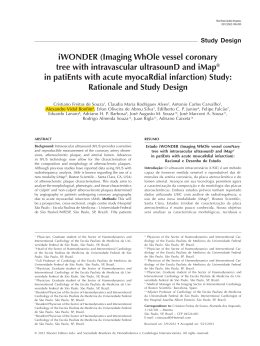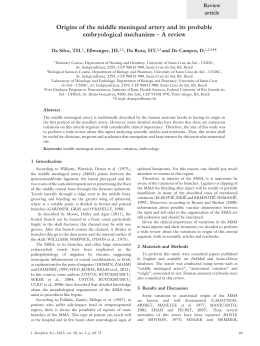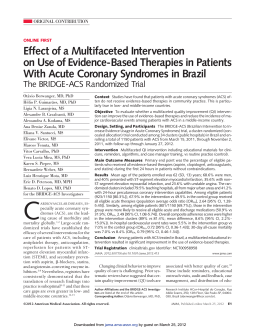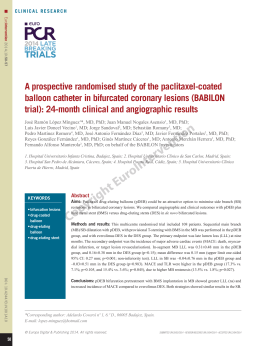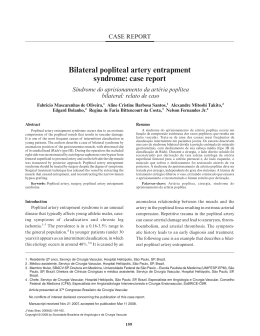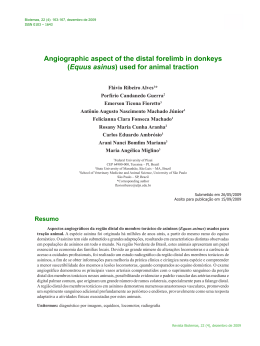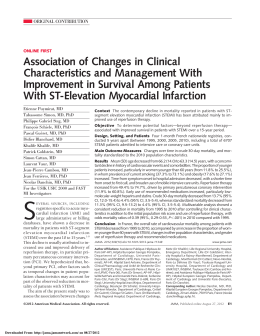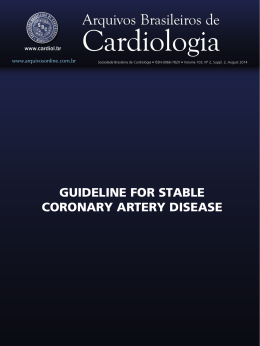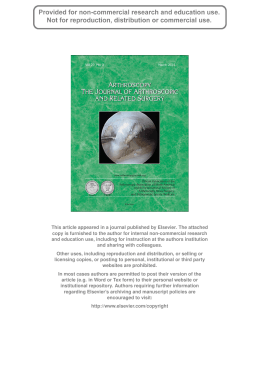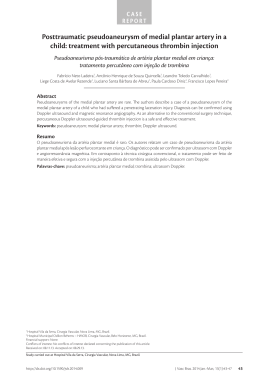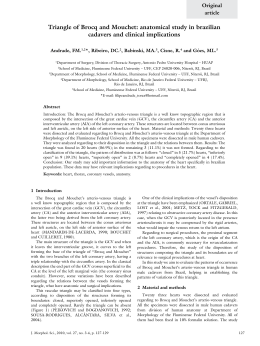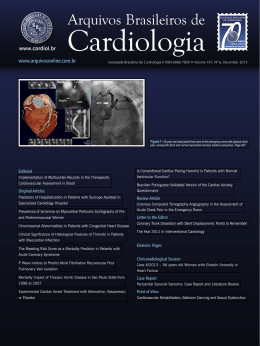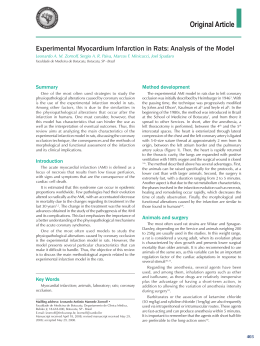CASE REPORT Rev Bras Cir Cardiovasc 2007; 22(2): 241-244 Fistula between anterior intraventricular coronary artery and the pulmonary artery trunk: Five operated patients Fístula entre artéria coronária interventricular anterior e o tronco arterial pulmonar: tratamento cirúrgico de cinco pacientes Islaine Cristina TOLEDO1, Valéria BRAILE2, João Carlos LEAL3, Domingo M. BRAILE4 RBCCV 44205-893 Abstract The current study reports the operative experience of patients with a coronary artery fistula between the anterior intraventricular coronary artery and pulmonary trunk. Of the five patients operated, 60% were women and the ages ranged form 40 to 46 years old. A stress echocardiogram and coronary cineangiography were accomplished for all patients. In the postoperative period no deaths occurred nor were symptoms reported. We believe that the surgical procedure is the first choice in the treatment of coronary artery fistulas, as it safely and effectively prevents complications of the arteriovenous shunt. Resumo O presente estudo relata a experiência operatória de pacientes portadores da fístula arterial coronária (FAC) entre a artéria coronária interventricular anterior e o tronco da pulmonar. Foram operados cinco pacientes, o sexo feminino foi mais freqüente, com 60% dos casos, e a idade variou de 40 a 46 anos. O ecocardiograma de stress e a cineangiocoronariografia foram realizados em todos pacientes. No pós-operatório, não houve mortalidade e presença de sintomas. Consideramos que procedimento operatório é a primeira escolha no tratamento da FAC, uma vez que previne as complicações do “shunt” artério-venoso, com segurança e eficácia. Descriptors: Arterio-arterial fistula, surgery. Angina pectoris, etiology. Pulmonary artery, pathology. Coronary vessel anomalies, surgery. Descritores: Fístula artério-arterial, cirurgia. Angina pectoris, etiologia. Artéria pulmonar, patologia. Anomalias dos vasos coronários, cirurgia. 1. Clinical Cardiologist of the Domingo Braile Heart Institute; Postoperative Intensivist of Cardiovascular Surgery, Hospital Beneficência Portuguesa, São José do Rio Preto 2. Clinical Cardiologist; Head of the Clinical Department of the Domingo Braile Heart Institute 3. Full member of SBCCV; Assistant professor in FAMERP. 4. Editor RBCCV. Work carried out in the Domingo Braile Heart Institute and Hospital Beneficência Portuguesa, São José do Rio Preto, Brazil Correspondence address: Islaine Cristina Toledo Rua Luis de Camões 3111, Redentora - São José do Rio Preto-SP. CEP: 15015-750. Tel: 17 3234-7048. E-mail: [email protected] Article received in November 25th, 2007 Article accepted in May 29th, 2007 241 TOLEDO, IC ET AL - Fistula between anterior intraventricular coronary artery and the pulmonary artery trunk: Five operated patients INTRODUCTION The diagnosis of coronary artery fistulas (CAF) occurs in 0.2% of patients submitted to coronary cineangiography, and is thus the second most common anomaly of coronaries arteries. It is defined as a direct communication between the coronary artery and a cardiac or vascular structure [1]. The first CAF was reported in 1865 by Krause [2]. Generally, the clinical state is silent, but when it becomes apparent, it is similar to obstructive coronary disease but the coronary arteries remain free of obstruction. Diagnosis is made in the cardiological evaluation. The symptoms are directly proportional to the caliber, size and fistula connection with, in some cases, it being identified in young patients. CAFs can occur in isolation or as multiples. In isolation they are more common with the right coronary artery being involved in 50% of cases. This disease can cause congestive heart failure with patients presenting all four functional classes as defined by the New York Heart Association (NYHA), as well as, associated congenital cardiac anomalies. The first successful surgical correction was reported by Björk & Craaford, in 1947 [3]. Our objective is to report on the surgical treatment of five patients with CAF between the anterior intraventricular coronary artery and the pulmonary trunk. METHODS Five patients with CAF between the anterior intraventricular coronary artery and the pulmonary trunk were submitted to surgery after diagnosis by coronary angiography (Figure 1). Sixty percent of cases were women and the ages varied from 40 to 46 years old. All patients presented with clinical symptoms of obstructive coronary disease with only one patient evolving to congestive heart failure (Functional Class III). Patients took beta blockers, calcium channel blockers and diuretics, without improvement of the symptoms. For two patients, electrocardiograms (ECG) demonstrated ischemic alterations but the serum enzymes, CKmb and cardiac troponin I, were normal. Stress echocardiograms identified ischemia in three patients. The patients were operated on by median sternotomy, followed by inverted T pericardiotomy. A cardiopulmonary bypass was used together with bicaval drainage and anterograde or retrograde tepid, low-volume blood cardioplegia. Longitudinal arteriotomy was performed in the pulmonary trunk. The ostium was closed using a bovine pericardium patch and 4.0 prolene sutures in all procedures. Following this, leakage of the retrograde blood cardioplegia, which is an efficient test in the intraoperative period, was evaluated. All procedures were uneventful. 242 Rev Bras Cir Cardiovasc 2007; 22(2): 241-244 Coronary angiographic studies were performed in the postoperative period, to check for fistulas and residual “shunts” (Figure 2). Fig. 1 - Coronary angiography showing coronary artery fistulas (FAC) Fig. 2 - Coronary angiographic studies in the postoperative period to check for fistulas and residual “shunts” TOLEDO, IC ET AL - Fistula between anterior intraventricular coronary artery and the pulmonary artery trunk: Five operated patients Rev Bras Cir Cardiovasc 2007; 22(2): 241-244 There were no deaths in the immediate and late postoperative periods and the patients remain asymptomatic. Written consent forms were signed by all the participants in this study. alternative is often used, a study, comparing the two procedures, demonstrated that the safety and effectiveness of surgery is 100%, as confirmed by coronary angiographic studies. Another study of adult patients with CAFs to the pulmonary artery demonstrated the efficacy of the surgical treatment over a follow-up period of up to seven years, without morbidity and mortality [5,8]. Surgery using cardiopulmonary bypass and myocardial protection has become the safest procedure to close the fistula opening, particularly when patients present more serious clinical conditions or access to the ostial location is difficult. Efflux should be evaluated by retrograde blood cardioplegia through the fistula opening in the intraoperative period to confirm the success of the surgery and also to help to identify the ostium when it is difficult to locate [9]. In Brazil, Groppo et al. [10] published their experience in surgeries of this type and reviewed publications on CAFs, demonstrating the low morbimortality rate. DISCUSSION In truth, anomalies of the coronary system are rare; studies of patients submitted to coronary angiographic evaluations demonstrated anomalies in 0.3 to 1.3% of the cases [1]. Fistulas of coronary arteries, when present, have symptoms similar to obstructive coronary insufficiency, with stable angina in most cases. However, in a study of young patients, 41.2% presented with stable angina. The variations in the intensity of the symptoms occur proportionally to the caliber, to the number of fistulas and depending on the connection with the heart chamber [4,5]. Fistulas of the right coronary artery are the most common (in about 70% of cases), but they also occur with the left coronary artery or even both arteries. Communications with the right heart chamber are the most prevalent, whereas connections to the pulmonary trunk correspond to about 20% of cases [1]. The clinical state depends on the blood flow through the fistula and on its location. The clinical manifestations are heart failure or dyspnea on effort. When coronary flow steal occurs it presents as precordialgia, sometimes, causing ischemic alterations at electrocardiography [1]. Infective endocarditis and endoarteritis are common in these patients depending on the location of the fistula. Additional to congestive heart failure, dilatation and general hypokinesia of the left ventricle can be observed by echocardiography [1]. Coronary angiographic studies are very important, as, apart from confirming the diagnosis, they provide an idea of the coronary circulation anatomy, the fistula location and the diameter of the artery involved. In respect to the therapeutic options, clinical treatment is based on preservation of the hemodynamic status by reducing the congestion, diminishing the myocardial contractility tension and, in some cases, improving the contractile force. The use of digitalis or dobutamine is indicated for children with heart failure and this may be associated with diuretics in the congestive phase. Beta blockers or calcium channel blockers function by reducing oxygen consumption, eliminating ischemia and the use of antibiotics for prophylaxis of infective endocarditis. However, optimization of clinical treatment, in some cases, does not improve the symptoms [1,6]. Percutaneous transcatheter embolization (PTE), considered an efficient alternative as it is less invasive compared to surgery, presents limitations. Even though this CONCLUSION Surgical treatment of CAFs safely and effectively prevents complications of arteriovenous shunts and should be considered for all patients where optimal clinical treatment is ineffective, even though a percutaneous procedure does exist. REFERENCES 1. Isolated coronary artery anomalies. Instant access to the minds of medicine. (Internet: http://securebar.secure-tunnel.com/cgibin/nph- freebar.cgi/110110A/http/www.emedicine.com/med/ topic445.htm) Last Updated: June 20, 2006. 2. Krause W. Uber den ursprung einer akzessorischen coronaria aus der pulmonalis. Z Rati Med. 1865;24:225. 243 TOLEDO, IC ET AL - Fistula between anterior intraventricular coronary artery and the pulmonary artery trunk: Five operated patients Rev Bras Cir Cardiovasc 2007; 22(2): 241-244 3. Björk G, Craaford C. Arteriovenous aneurysm of the pulmonary artery simulating patent ductus arteriosus Botalli. Thorax. 1947;2(1):65. congestive heart failure from a left main to coronary sinus fistula. Cardiol Rev. 2004;12(1):59-62. 4. Mavroudis C, Backer CL, Rocchini AP, Muster AJ, Gevitz M. Coronary artery fistulas in infants and chidren: a surgical rewiew and discussion of coil embolization. Ann Thorac Surg. 1997;63(5):1235-42. 5. Cherif A, Farhati A, Fajraoui M, Boussaada R, Hmam M, Ezzar T, Mourali S, et al. Coronary-pulmonary fistula in the adult: report of 6 cases and review of the literature. Tunis Med. 2003;81(8):595-9. 6. Dahiya R, Copeland J, Butman SM. Myocardial ischemia and 244 7. Goto Y, Abe T, Sekine S, Iigima K, Kondoh K, Sakurada T. Surgical treatment of the coronary artery to pulmonary artery fistulas in adults. Cardiology. 1998;89(4):252-6. 8. Sakakibara S, Yokoyama M, Takao A, Nogi M, Gomi H. Coronary arteriovenous fistula: nine operated cases. Am Heart J. 1966;72(3):307-14. 9. Groppo AA, Coimbra LF, Santos MVN. Fístula da artéria coronária: relato de três casos operados e revisão da literatura. Rev Bras Cir Cardiovasc. 2002;17(3):271-5.
Download
